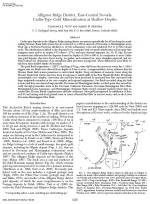Добрый день, Коллеги. Важное сообщение, просьба принять участие. Музей Ферсмана ищет помощь для реставрационных работ в помещении. Подробности по ссылке
Alligator Ridge District, East-Central Nevada: Carlin-type gold mineralization at Shallow Depths
Carlin-type deposits in the Alligator Ridge mining district are present sporadically for 40 km along the north-striking Mooney Basin fault system but are restricted to a 250-m interval of Devonian to Mississippian strata. Their age is bracketed between silicified ca. 45 Ma sedimentary rocks and unaltered 36.5 to 34 Ma volcanic rocks. The silicification is linked to the deposits by its continuity with ore-grade silicification in Devonian-Mis-sissippian strata and by its similar δ18O values (~17‰) and trace element signature (As, Sb, Tl, Hg). Eocene reconstruction indicates that the deposits formed at depths of ≤300 to 800 m. In comparison to most Carlin-type gold deposits, they have lower Au/Ag, Au grades, and contained Au, more abundant jasperoid, and tex-tural evidence for deposition of an amorphous silica precursor in jasperoid. These differences most likely result from their shallow depth of formation.
The peak fluid temperature (~230°C) and large δ18OH2O value shift from the meteroric water line (~20‰) suggest that ore fluids were derived from depths of 8 km or more. A magnetotelluric survey indicates that the Mooney Basin fault system penetrates to mid-crustal depths. Deep circulation of meteoric water along the Mooney Basin fault system may have been in response to initial uplift of the East Humboldt-Ruby Mountains metamorphic core complex; convection also may have been promoted by increased heat flow associated with large magnitude extension in the core complex and regional magmatism. Ore fluids ascended along the fault system until they encountered impermeable Devonian and Mississippian shales, at which point they moved laterally through permeable strata in the Devonian Guilmette Formation, Devonian-Mississippian Pilot Shale, Mississippian Joana Limestone, and Mississippian Chainman Shale toward erosional windows where they ascended into Eocene fluvial conglomerates and lake sediments. Most gold precipitated by sulfidation of host-rock Fe and mixing with local ground water in zones of lateral fluid flow in reactive strata, such as the Lower Devonian-Mississippian Pilot Shale.




